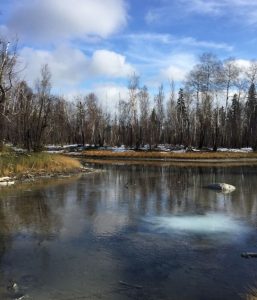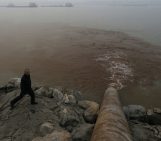
Post by Scott Jasechko, University of Calgary
Groundwater is the world’s largest family of fresh and unfrozen water, and its members range from young to old. There are toddler groundwaters recharged more recently than the year ~1960. Our earlier research showed that these modern groundwaters make up only a small share of global groundwater stocks (Ref. 1 and Water Canada).
But what of ancient ‘fossil’ groundwater—defined as groundwater that first moved under the ground more than 12,000 years ago, before the current “Holocene” time period began?
Many studies have discovered fossil groundwaters (Refs. 2-7). These ancient groundwaters may have first become isolated under the ground during one of the ice ages (~12,000 to 2.6 million years ago), or when dinosaurs wandered the planet (230 to 65 million years ago), or even before complex multicellular life evolved (e.g., more than 1 billion years ago).
Our research shows that fossil groundwaters are widespread, based on a compilation of groundwater radiocarbon, which is common in young groundwaters but less common in fossil groundwaters.
Our recent work (Ref. 8) has two main findings:
First, we show that fossil groundwater likely makes up most of the fresh and unfrozen water on planet Earth. Fossil groundwater is common at depths deeper than ~250 meters below the ground. Our finding highlights that most aquifers take a long time to be flushed, implying that most groundwater is not rejuvenated at time scales that are consistent with water management timeframes (~decades).
Second, we show that many deep well waters that are dominated by fossil groundwater also contain some modern groundwater. That is, fossil well waters are often mixed up with recent rain and snowmelt. Because some human activities pollute recent rain and snowmelt, our finding implies that deep wells are not immune to the impacts of modern-day land uses on water quality.
Back to our family analogy – our two main findings are: (i) ‘groundwater grandparents’ (i.e., fossil water) make up most of the global groundwater family (lots of grandparents, only a few grandchildren), however, (ii) groundwater youngsters (less than ~50 years in their age), are often found to hang out at deep depths with groundwater grandparents. Once in a while, youngsters may carry the consequences of bad modern habits (i.e. contamination) down to the deep depths where the groundwater grandparents live, sullying deep groundwaters once considered immune to modern contamination.

Fossil groundwater discharges to the surface near the Clearwater River of northeast Alberta (56.735°N 110.471°W; video of the spring https://vimeo.com/211124266)
References
1) Gleeson T, Befus K, Jasechko S, Luijendijk E, Cardenas MB (2016) The global volume and distribution of modern groundwater. Nature Geoscience, 9, 161-168. http://www.nature.com/ngeo/journal/v9/n2/full/ngeo2590.html
2) Thatcher L, Rubin M, Brown GF (1961) Dating desert groundwater. Science 134, 105-106. http://science.sciencemag.org/content/134/3472/105
3) Edmunds WM, Wright EP (1979) Groundwater recharge and palaeoclimate in the Sirte and Kufra basins, Libya. Journal of Hydrology 40, 215-241. www.sciencedirect.com/science/article/pii/0022169479900325
4) Phillips FM, Peeters LA, Tansey MK, Davis SN (1986). Paleoclimatic inferences from an isotopic investigation of groundwater in the central San Juan Basin, New Mexico. Quaternary Research 26, 179-193. http://www.sciencedirect.com/science/article/pii/0033589486901031
5) Remenda VH, Cherry JA, Edwards TWD (1994). Isotopic composition of old ground water from Lake Agassiz: implications for late Pleistocene climate. Science, 266, 1975-1978. science.sciencemag.org/content/266/5193/1975
6) Sturchio NC et al. (2004) One million year old groundwater in the Sahara revealed by krypton-81 and chlorine-36. Geophysical Research Letters 31, L05503. onlinelibrary.wiley.com/doi/10.1029/2003GL019234/full
7) Holland G, Sherwood Lollar B, Li L, Lacrampe-Couloume G, Slater GF, Ballentine CJ (2013) Deep fracture fluids isolated in the crust since the Precambrian era. Nature 497, 357-360. http://www.nature.com/nature/journal/v497/n7449/full/nature12127.html
8) Jasechko S, Perrone D, Befus KM, Cardenas MB, Ferguson G, Gleeson T, Luijenjijk E, McDonnell JJ, Taylor RG, Wada Y, Kirchner JW (2017) Global aquifers dominated by fossil groundwaters but wells vulnerable to modern contamination. Nature Geoscience doi:10.1038/ngeo2943.


